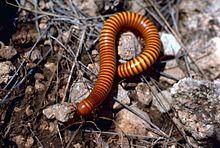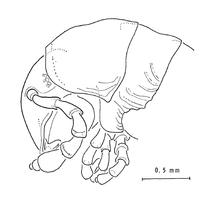| Spirostreptida | |
|---|---|
 | |
| Orthoporus sp. (Spirostreptidae) from North America | |
| Scientific classification | |
| Kingdom: | |
| Phylum: | |
| Class: | |
| Subclass: | |
| Infraclass: | Helminthomorpha |
| Superorder: | Juliformia |
| Order: | Spirostreptida Brandt, 1833 |
| Families | |
| 10: see text. | |
Spirostreptida is an order of long, cylindrical millipedes. There are approximately 1000 described species,[1] making Spirostreptida the second largest order of millipedes after Polydesmida.
Description
Spirostreptida are generally large, long and cylindrical, with 30 to 90 body rings. Eyes are present in most.[2] This order contains the longest millipedes known: the giant African millipedes of the genus Archispirostreptus that may exceed 30 centimetres (12 in).[2]
Distribution
Spirostreptida contains mainly tropical species, and occurs in Africa, Southern Asia to Japan, Australia, and the Western Hemisphere from the United States to Argentina.[3]
Classification
The order comprises two suborders, Cambalidea and Spirostreptidea, the latter further divided into two superfamilies.[1]
Suborder Cambalidea
- Cambalidae
- Cambalopsidae (includes the former Glyphiulidae and Pericambalidae)[1]
- Choctellidae
- Iulomorphidae
- Pseudonannolenidae
Suborder Spirostreptidea
- Superfamily Odontopygoidea
- Atopogestidae
- Odontopygidae
- Superfamily Spirostreptoidea
- Adiaphorostreptidae
- Harpagophoridae
- Spirostreptidae
Select species
- Phyllogonostreptus nigrolabiatus- a large species from India
- Spinotarsus caboverdus- a species that has become an agricultural pest in Cape Verde
References
- ^ a b c Shear, W. (2011). "Class Diplopoda de Blainville in Gervais, 1844. In: Zhang, Z.-Q. (Ed.) Animal biodiversity: An outline of higher-level classification and survey of taxonomic richness" (PDF). Zootaxa. 3148: 159–164.
- ^ a b "Diagnostic features of Millipede Orders" (PDF). Milli-PEET Identification Tables. The Field Museum, Chicago. Retrieved 25 October 2013.
- ^ Shelley, Rowland M. (1999). "Centipedes and Millipedes with Emphasis on North American Fauna". The Kansas School Naturalist. 45 (3): 1–16.
External links
 Media related to Spirostreptida at Wikimedia Commons
Media related to Spirostreptida at Wikimedia Commons Data related to Spirostreptida at Wikispecies
Data related to Spirostreptida at Wikispecies- "Spirostreptida" at the Encyclopedia of Life

